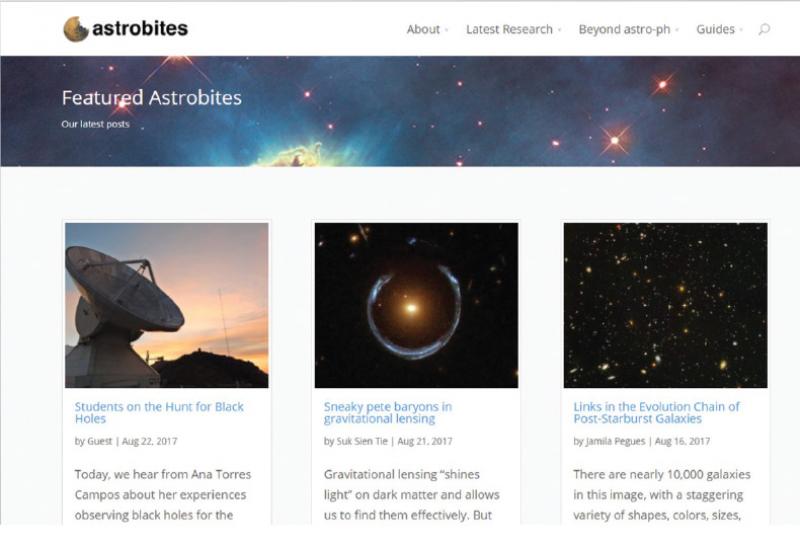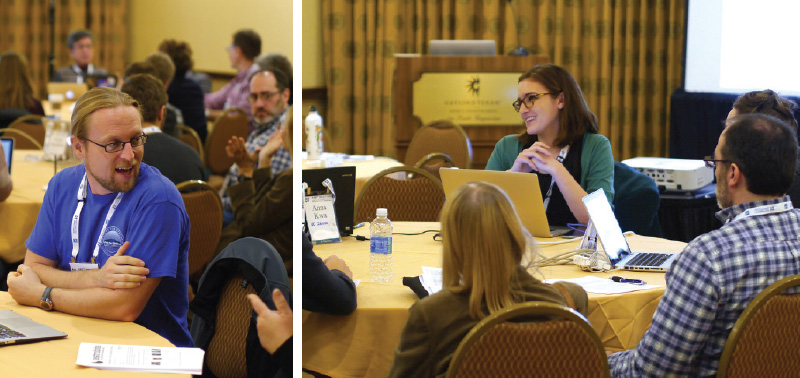Bringing Astronomy Research into the Classroom with Astrobites
Fall
2017
Feature
Bringing Astronomy Research into the Classroom with Astrobites
Susanna Kohler, Astrobites Administrator

Newton’s laws, Keplerian orbits, geometrical optics—the science discovered hundreds of years ago is crucial for building a foundation in physics and astronomy. But shouldn’t we also be sharing the field’s latest breakthroughs with early-career scientists? Experiencing the excitement of the Kepler mission’s latest exoplanet discoveries is arguably just as important in astronomy education as learning about Kepler’s laws.
Unfortunately, accessing recent research developments is often easier said than done. Scientific literature tends to be dense and difficult to parse for anyone not in the immediate field. Seven years ago, a team of graduate students tackled this problem and brought a new resource to life: Astrobites.
Meet Astrobites
Astrobites is a daily blog that acts as a reader’s digest of astrophysical literature, making current astronomy results accessible to more than just the researchers in that field. Every day a graduate student from the Astrobites collaboration selects one article from the arXiv, a public preprint server where scientists publish their work, and summarizes it in a brief post intended to be understandable by undergraduate physics and astronomy majors.
Astrobites posts typically run around 500–1500 words, and they strive to be jargon-free. Each Astrobites summary first provides the background that readers might need, explaining the historical context for the research and why the study presented in this paper is important. The summaries then present the main results from the paper and a few plots or figures from the study, with careful explanation of what’s being represented in each. All Astrobites posts include a link back to the original article—which is freely available on the arXiv—so that readers can easily access the full study for more information after they read the Astrobites summary.
Growth and Expansion
Astrobites has grown rapidly since its inception in 2010. The blog is now powered by a rotating team of graduate-student volunteers from around the country and the world, with a roster of about 30 authors active each year. Over the past seven years, Astrobites’ 100+ current and alumni authors have collectively built an archive on the site of more than 1,500 summaries of astrophysical research papers. During this time, Astrobites’ readership has grown to more than 17,000 unique visitors per month, encompassing undergraduates, graduates, educators, researchers, and astronomy enthusiasts.
In addition to paper summaries, Astrobites also strives to offer other information useful for undergraduate physics and astronomy majors. The site features posts on career navigation (with subjects like how to study for the physics GRE, or how to apply to graduate school), personal experiences (with subjects like what it’s like to travel to Antarctica to use the South Pole Telescope, or interviews with notable scientists in the field), and current events (with summaries from recent astronomical meetings, or discussions of hot topics like NASA press conferences). Astrobites even has a section devoted to publishing brief posts submitted by undergraduate readers summarizing their own research projects.
Formalizing Support for Educators
Astrobites is also expanding directly into the classroom. Educators began independently using Astrobites in their classes within the first year of the site’s formation. The Astrobites organization interviewed these educators early on and compiled a summary of their strategies for incorporating Astrobites into undergraduate classes. This summary appeared as a published article in the Astronomy Education Review (Sanders et al. 2012).
This year, the organization has moved to formalize its support for educators seeking to adopt Astrobites as an instructional tool. The 229th meeting of the American Astronomical Society in January 2017 marked the initiation of an Astrobites educator support workshop titled, “Introducing Current Research into Your Classroom.” The workshop brought together 25 instructors from higher-education institutes with a team of Astrobites graduate-student authors to discuss effective ways to use Astrobites in science classes and to brainstorm how the Astrobites collaboration can better support such use.

Classroom Strategies Summarized
The workshop covered three specific examples for how Astrobites could be incorporated into classes: providing Astrobites posts for reading assignments, having students conduct a research project based on Astrobites articles, and having students write their own Astrobites-style posts.
1. Astrobites posts as reading assignments
In this activity, students are asked to read an assigned Astrobites article and respond to guided questions that test reading comprehension and conceptual understanding. This approach can be used as a way of supporting the fundamental topics covered in class with recent research results in the field. It also helps to expose students to the process of how science is done. One way these readings could be used is as pre-lab assignments, to connect lab activities to current research.
2. Astrobites research projects
In this activity, students are asked to select a research topic and then identify and read several Astrobites articles related to that topic. Students then prepare a written paper or class presentation based on this independent research. In advanced courses, students can be asked to read the original paper as well, so that the Astrobites article serves as scaffolding to introduce them to that material. This activity allows students to explore a topic in more depth, providing them with access both to the context and the current research results related to that topic.
3. Write your own Astrobite
In this project, designed with upper-level undergraduate or graduate classes in mind, students write their own Astrobites-like article to summarize the content of one or more research papers. This activity helps students build research, literature-understanding, and communication skills.
Materials Available
The educators at the workshop left with a full set of lesson-plan materials produced by Astrobites—including step-by-step instructions, suggestions for adapting the lessons to different class levels across the undergraduate and graduate spectrum, sample student handouts, and grading rubrics—as well as personalized discussions of how they could adapt these materials to their classes.
Meanwhile, the Astrobites collaboration gained direct feedback from educators on how to improve the above materials and their support for more effective use in undergraduate and graduate classrooms. The collaboration updated the lesson-plan materials based on the educator feedback, and they have now been published in the American Journal of Physics (Sanders et al. 2017). They are also publicly available on the arXiv (https://arxiv.org/abs/1706.01165). Naturally, this new paper has already been covered on Astrobites (https://astrobites.org/2017/06/11/astrobites-lesson-plans/).
Connecting with You
Since Astrobites’ launch, dozens of educators have sent in reports of how they have used the site with their students. Some have incorporated the site into undergraduate and graduate classes, some use the site to introduce new astronomy researchers to the literature, and several have even organized Astrobites-based journal clubs at their home institutions.
The Astrobites collaboration is delighted with the education community’s adoption of the site and is eager to continue to build this joint effort to augment astronomy and physics education with current research results. If you, too, are interested in using Astrobites in your classroom or at your institute, the Astrobites collaboration is here to help! And whether or not you’d like assistance, the team would love to hear about your experience. You can contact the collaboration at astrobites [at] gmail.com.
____________________________________________________
References
Site: http://astrobites.org
Lesson-plan materials: https://arxiv.org/abs/1706.01165
N. E. Sanders et al., “Preparing undergraduates for research careers: Using Astrobites in the classroom,” Astron. Educ. Rev. 11, 010201 (2012).
N. E. Sanders et al., “Incorporating current research into formal higher education settings using Astrobites,” Am. J. Phys, 85, 10 (2017).
